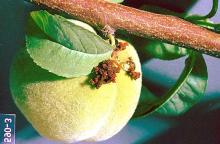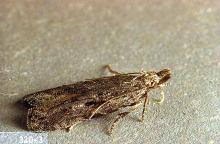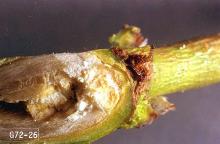Anarsia lineatella
Pest description and crop damage Peach twig borer is a European insect first found in California in the 1880s. It is a major pest of apricots, peaches, plums, and prunes. There are no native hosts outside the orchard. The adult is a gray moth with white and dark scales, about 0.3 to 0.5 inch long. The larva is a caterpillar, about 0.5 inch in length, with a dark brown head and distinctive, alternating light and dark bands on the body. The pupa is smooth and brown. The larva of the borer causes injury to fruit and trees as they feed on the buds and twigs early in the season. Later, the larva bores into the shoots, causing a characteristic "flagging" or wilting of new growth. Later generations of larvae feed on shoots or fruit, disfiguring the fruit. Flagging of twigs indicates an infestation.
Biology and life history The borer overwinters as an immature larva within tunnels constructed in the crotches of twigs and branches. These overwintering sites can be identified by the small chimneys of frass (excrement) and wood fragments produced by the feeding of the larvae. Larvae become active at the pink bud stage and emerge to feed on buds and young leaves before boring into a shoot. These larvae eventually leave the mined shoot to pupate. Adults then emerge in mid- to late May. Eggs are laid on fruit, shoots, or undersides of leaves. Eggs are yellowish white to orange. The eggs hatch, and these larvae feed and mature on shoots and immature fruit. The next adult flight is in mid-July. Some of the larvae from this flight will overwinter, and the rest will produce a partial third flight.
Pest monitoring Check for overwintering sites on small trees. Otherwise, examine shoots in late April or early May. Wilted shoots are easy to spot, and you should open them to check for larvae.
Management-biological control
Tiny parasitic chalcid wasps are active in orchards at shuck fall that parasitize moth eggs, while braconid wasps parasitize borers within plant tissues.
Management-cultural control
Home Orchardists: Cut out mined shoots below the wilted area to eliminate larvae. Overwintering larvae may be found and destroyed under thin bark in branch crotches. Look for a buildup of chewed bark and frass (excrement) when monitoring.
Management-chemical control
Warning: Many pesticides are hazardous to bees. Look for bee precautionary statements on product labels and do not use these products during bloom or if bees are foraging in the orchard.
Management-chemical control: HOME USE
- azadirachtin (neem oil)-Some formulations OMRI-listed for organic use.
- carbaryl-Highly toxic to bees.
- gamma-cyhalothrin-Highly toxic to bees.
- kaolin-Applied as a spray to leaves, stems, and fruit, it acts as a repellant to some insect pests. Some formulations are OMRI-listed for organic use.
- lambda-cyhalothrin-Highly toxic to bees.
- pyrethrins-Highly toxic to bees. Some formulations are OMRI-listed for organic use.
- spinosad-Toxic to bees. Some formulations are OMRI-listed for organic use.
- zeta-cypermethrin-Highly toxic to bees.
Management-chemical control: COMMERCIAL USE
Prebloom spray
- flubendiamide+buprofezin (Tourismo) at 10 to 14 fl oz/A. REI 12 hr.
- spinetoram (Delegate WG) at 3 to 7 oz/A. REI 4 hr.
- spinosad (Entrust SC) at 4 to 8 fl oz/A. REI 4 hr. Results are best when applied at petal fall. May act slowly. OMRI-listed for organic use.
Spring and summer spray
- Bacillus thuringiensis var. kurstaki-Check labels for rates. REI 4 hr. PHI 0 days. Bt products work best if temperatures exceed 50°F over 3 consecutive days.
- diazinon (Diazinon 50W) at 1 lb/100 gal water (4 lb/A). Do not apply more than 4 lbs. of product or 6 gals. of oil per acre per year. REI 4 days. PHI 21 days. Do not exceed one in-season foliar application per growing season.
- flubendiamide+buprofezin (Tourismo) at 10 to 14 fl oz/A. REI 12 hr. PHI 14 days.
- phosmet (Imidan 70W) at 2.13 to 4.25 lb/A. REI 7 days. PHI 14 days. Mechanical harvest permitted 7 days after application.
- spinetoram (Delegate WG) at 4.5 to 7 oz/A. REI 4 hr. PHI 1 day.
- spinosad (Entrust SC) at 4 to 8 fl oz/A. REI 4 hr. PHI 1 day. Results are best when applied at petal fall. May act slowly. OMRI-listed for organic use.
- thiamethoxam+chlorantraniliprole (Voliam Flexi) at 4 to 7 oz/A. Do not apply exceed 14 oz/A of Voliam Flexi per season. REI 12 hr. PHI 14 days.



